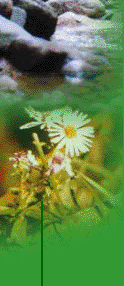|
REASON FOR THE RESEARCH |
Due to the loss of a fiancÚ and some friends to Mr. Duda; the fact that Mr.McDonald's father
had cancer, which was removed, and the loss of his father-in-law to cancer, prompted this research. |
|
ORIGINAL HYPOTHESIS
|
A high concentration of some chemical element in the body was causing the cells to fail to cease
reproduction in the normal way. |
|
ORIGINAL FINDINGS |
The blood type inside the tumor mass is different than that of the patient's primary blood type.
People with type A blood get more malignant tumors that any other blood type. |
|
ORIGINAL RESEARCH METHODS |
Many copies of abstracts and articles in the Harvard Medical
Research Library were read and cross-correlated to see if anything may have been overlooked. |
|
FURTHUR FINDINGS |
It was noted that Nitrogen levels were lowered in the main
body, but excessive in the tumor masses. Also N-Acetylglucosamine and by-products of it's breakdown are excessive in patients
with malignant tumors. N-Acetylglucosamine is the sugar chain that differentiates type A blood types from other types. There
are 10 known sub-types of type A Blood. The sub-types of A inside the tumor is lower than that of the body's primary type
A (That is A2 in the body, A6 inside the tumor.) Blodd types are determined by adding an anti-antigen to a sample and depending
on the reactions the type is determined. (If Anti-A causes agglutination. The type is A; If Anti-B causes agglutination the
type is B; If both cause agglutination the type is AB; if neither causes agglutination they type is O.) |
|
QUESTIONS THAT AROSE AND RESPONSES FROM MEDICAL SOURCES |
|
What would happen in Anti-A1 were injected into a patient with type
O blood? |
Nothing, as type O and B patients have Anti-A in their systems
at all times in very low concentrations, but if it is used it is slow to be replaced. |
|
What would happen if Anti-A1 were injected into a patient with type
A or AB blood? |
Treatment fatal - demise of patient imminent. At first it would be like a blood transfusion
reaction in symptoms. |
|
What would happen if Anti-A5 were injected into a patient with type
A2 blood? |
There may be a slight reaction, but there should be no harm to the patient. |
|
What would happen to any cells or tumor with type A6 in them in
a patient with type A2 blood if Anti-A5 were added to the patients blood? |
The blood entering those cells would agglutinate and thus
the cells would die due to lack of nutrients and oxygen. |




